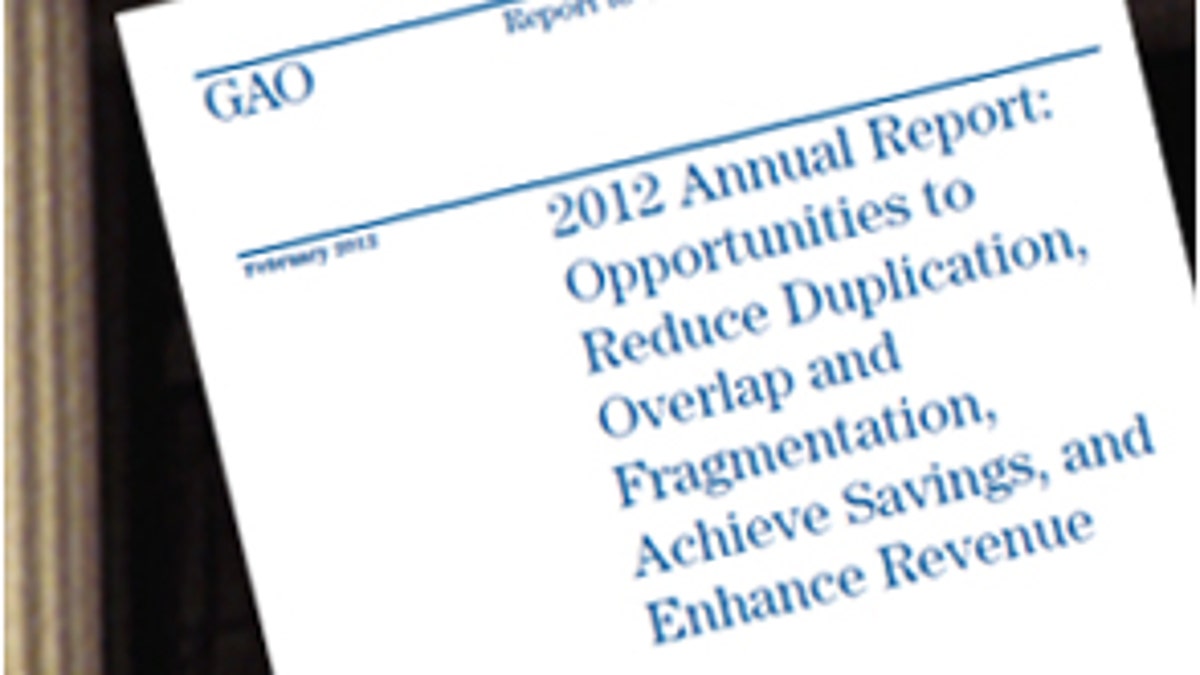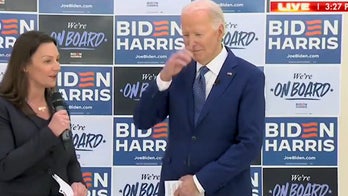
(GAO.gov)
As lawmakers across the Capitol hear appeals Tuesday from Obama administration secretaries pleading for their budgets, duplication and overlap in dozens of areas of government is wasting "tens of billions of dollars annually," a new government report shows.
According to the Government Accountability Agency's 2012 annual report, nearly every department of the Executive Branch has room for improvement.
The report, which gives 51 areas and recommends 130 actions, follows a 2011 GAO report that showed 81 areas and 176 actions to be taken to "reduce or eliminate unnecessary duplication, overlap, or fragmentation or achieve other potential financial benefits."
"Collectively, these reports show that, if the actions are implemented, the government could potentially save tens of billions of dollars annually," Gene Dodaro, comptroller general for the U.S., said in remarks prepared for Tuesday's hearing in the House Oversight and Government Relations Committee.
Sen. Tom Coburn, R-Okla., also a witness Tuesday, estimated that waste and duplication costs taxpayers more like $100 billion per year.
"Not one corner of our daily life remains untouched by a government program or federal effort," Coburn said in testimony being delivered Tuesday. "From what we eat and drink, to where we live, work, and socialize, nearly every aspect of human behavior and American society are addressed by multiple government programs."
Coburn said last year's report listed more than 100 surface transportation programs; 88 economic development programs; 82 teacher quality programs; 56 financial literacy programs; 47 job training programs; 20 homelessness prevention and assistance programs; 18 food for the hungry programs; and 17 disaster response and preparedness programs.
He said government's duplication in nutritional programs alone -- worth $62.5 billion in 2008, according to GAO -- have burned taxpayers over items as simple as potato chips.
"While many of these programs, such as the Supplemental Nutrition Assistance Program (SNAP) allow federal funds to purchase potato chips, dozens of other government-wide initiatives, are aimed at keeping Americans healthy, specifically suggesting food like potato chips should be limited in intake, and perhaps even taken out of public schools all together," he said.
"At the same time, just this year the Department of Agriculture announced a nearly $50,000 federal grant was being doled out to a private potato chip company in New York. According the proposal, this money would be used to overhaul their media strategy and raise
brand awareness and consumer knowledge -- essentially encouraging people to buy and consume potato chips," he said, noting that potato chips sales in the United States exceed $6 billion annually.
Coburn said that sales level "begs the question why the taxpayers are now asked to subsidize promotion and marketing for the industry."
Click here to read Dodaro's testimony.
Click here to read the GAO report.
Click here to read Coburn's testimony.
GAO categorizes the areas for improvement into a dozen specialty areas. For the Justice Department, for instance, GAO says $3.9 billion is offered in 11,000 grant awards where there is a "risk of potential unnecessary duplication."
The Defense Department, he said, needs a department-wide strategy for spending $37.5 billion on unmanned aircraft over the next five years. Dodaro offered the example of the Navy spending $3 billion to create its own version of an Air Force surveillance program that is already operational.
"According to program officials, no analysis was conducted to determine the cost effectiveness of developing the Broad Area Maritime Surveillance UAS to meet the Navy's requirements versus buying more (Air Force) Global Hawks," Dodaro said.
GAO also lists areas for improvement in science, engineering, transportation, food safety and security clearances, among others.
On housing, Dodaro said the Treasury and Federal Reserve invested more than $1.67 trillion in
Fannie Mae and Freddie Mac in 2010, while GAO identified "20 different entities that administer 160 programs, tax expenditures and other tools" designed to support home ownership and rental
housing while another "39 programs, tax expenditures, and other tools" offered help in buying, selling or financing a home. Eight more programs and tax expenditures were designed for rental property owners.
Meanwhile, Dodaro noted, 56 percent of Rural Housing Service loan guarantees were for urban properties in 2009 while the Federal Housing Administration insured eight times as many single-family loans in rural counties as RHS did.
Writing on the White House blog on Tuesday, Danny Werfel, controller of the Office of Federal Financial Management, said that GAO's 2012 report was finished before the release of President Obama's 2013 budget, which includes additional measures to those already taken by the administration since the prior GAO report.
Werfel said consolidation is already taking place without Congress' sign-off, including the merger of six business and trade agencies into one, consolidation of 1,200 data centers by 2015 -- 100 of which have already closed and 500 of which are already slated to close -- and the reduction of agency real estate costs by $3 billion by the end of the year.
Werfel wrote that "nearly 80 percent of the issue areas for which GAO recommended action last year, and more than three-quarters of the recommendations for Executive Branch actions associated with those areas (76 percent) were addressed in some way."
He said Congress, which addressed less than 40 percent of the recommendations requiring congressional action in some way, could do more by passing the president's budget as well as the Reforming and Consolidating Government Act, which he said the administration sent to Capitol Hill earlier this year as a plan to set up an expedited process to review government consolidation proposals.
Dodaro said much of the the low-hanging fruit outlined in last year's report has been addressed in the latest budget but there "needs to be more assertive action" from the Office of Management and Budget.
He said one easy fix would be to eliminate differences in the coding practices for Medicare Advantage versus traditional Medicare.
Diagnostic coding for Medicare Advantage estimated a 3.41 percent higher risk scores for beneficiaries, totaling about $2.7 billion in greater payments. The reason for that, he said, is because Medicare Advantage providers get paid by the diagnostic code while traditional Medicare providers are paid by the services rendered.
"We estimated that a revised methodology that addressed these shortcomings could have saved Medicare between $1.2 billion and $3.1 billion in 2010 in addition to the $2.7 billion in savings that CMS’s 3.41 percent adjustment produced," he said.
Committee Chairman Darrell Issa, R-Calif., said in a statement before the hearing that taxpayers deserve more "modern, efficient and cost-effective operations" in government, especially in times of fiscal crisis.
"I have always said that the enemy isn't the Democrats, the enemy isn't the Republicans -- it's the bureaucracy. A bureaucracy that inherently resists change and adaptation," he said.
But while Issa said the hearing was not convened to cast blame, Coburn said "Congress is the main offender" allowing runaway spending.
"We set the budget, we pass the appropriations bills and we authorize new activities at the federal agencies. We refuse to apply metrics and standards to the programs we create. We ignore our duty to conduct oversight. And we choose to remain uninformed about existing efforts before creating new ones," he said.




